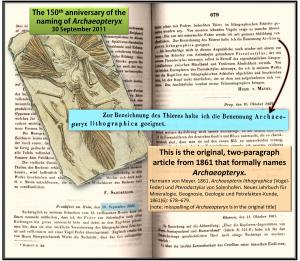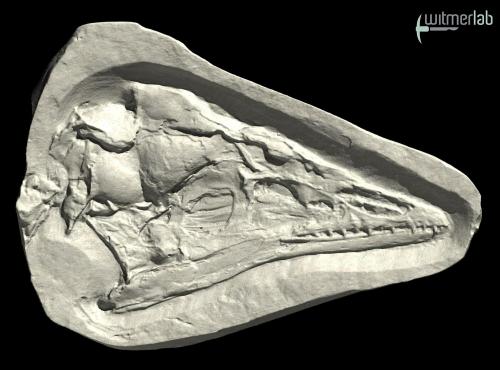
The actual 1861, two-paragraph article with the single, controversial sentence pulled out that names Archaeopteryx lithographica.
It was 150 years ago today, on 30 September 1861, that Hermann von Meyer gave the name Archaeopteryx lithographica to the feathered animal that fluttered over the Solnhofen lagoon in Late Jurassic Bavaria. At right is the entire published article…a scant two paragraphs, only one of which is devoted to Archaeopteryx. In that one paragraph he announced the discovery of a feathered skeleton, to go along with the isolated feather that he had announced six weeks earlier. For decades later, scholars argued over his key statement: “For the denomination of the animal I consider the term Archaeopteryx lithographica as appropriate” (the original German sentence is pulled out in the illustration). He named the animal, but not a specimen. Modern rules dictate the designation of a “holotype” specimen that officially bears the name. Should it be the feather, the skeleton, or neither? I discussed this debate a little in my first Archaeopteryx sesquicentennial post, but the result has been that the skeleton—now known as the London Specimen (BMNH 37001)—is the holotype. Happy 150th Birthday, Archaeopteryx! To celebrate, WitmerLab is launching today a website with five sets of interactive 3D PDFs of skull or skull parts of three Archaeopteryx specimens, including the one von Meyer announced 150 years ago today. It’s all open access and freely downloadable!

The skull of the Eichstätt Archaeopteryx (JM 2257), based on microCT scanning of a high-resolution cast made by Peter Wellnhofer for Witmer.

Screen capture of the 3D PDF of the London specimen braincase. To launch the 3D PDF visit the main site (http://bit.ly/njtGdH).
About the specimens used for the 3D PDFs
The five specimens we used are all research casts in our collection. Three of the casts were high-resolution replicas made by Peter Wellnhofer himself for me years ago. These three are the Eichstätt specimen’s skull, the front of the Berlin specimen’s skull, and the upper jaw fragments on the counterslab of the London specimen. The other two casts were part of the London specimen cast that we purchased from the Natural History Museum a number of years ago. These two pieces include the braincase (which I published on way back in 1990). This braincase was CT scanned about a decade ago, and a definitive article was published by Angela Milner’s team in Nature in 2004 detailing the structure of the brain endocast and inner ear. Angela kindly gave me access to those scan data, but we chose to use our cast for our 3D PDF. The other London piece is a problematic bone that has been regarded as a quadrate bone or maybe even the sphenoid region of the braincase.

Screen capture of the 3D PDF of the Eichstätt specimen skull. To launch the 3D PDF visit the main site (http://bit.ly/njtGdH).
About the scanning and 3D PDFs
All five of these specimens were scanned on the Ohio University microCT scanner (OUµCT) at an isotropic voxel size of 45 µm. To be honest, this entire project started off as an experiment to see if we could get decent, useable surfaces from the casts. We needed to do some test scans after some maintenance work so we tossed in one of the casts. The test scan came out really well, recording basically all the detail inherent in the cast. So we scanned the rest. Ryan Ridgely’s prodigious 3D viz skills were hardly taxed at all on this project, and we had beautiful 3D PDFs in no time. These 3D PDFs are provided on the main Archaeopteryx3d PDFs website in multiple resolutions so that you can match your interest to the power of your computer or speed of your connection. I wanted to put up some big files (a juicy 55 MB file of the Eichstätt skull!) so that specialists can really go to work. We’ve been using 3D PDFs for years, including recently on our 3D Alligator site and 3D Interactive Human Anatomy site, but check out our 3D Visualization page for more goodies.

Screen capture of the 3D PDF of the Berlin specimen skull. To launch the 3D PDF visit the main site (http://bit.ly/njtGdH).
In closing, regardless of whether Archaeopteryx is part of the avian lineage or nearby on the deinonychosaur line (see my recent post stemming from the Xiaotingia article), these specimens of Archaeopteryx are critical documents in the evolutionary history of birds. We’re proud to be taking an active role in the sesquicentennial year and to provide some hopefully useful resources for the community.
–Larry Witmer



[…] up the chance to contribute to Dinosaur Tracking. Since Bavaria’s very own Archaeopteryx was named 150 years ago today, on September 30, 1861, here’s my account of the small but charming Paläontologisches Museum […]
These PDFs are a great resource, just like all the brilliant work you have been doing in the past two decades. Thanks for making them available.
[…] Comments « Celebrating the 150th birthday of Archaeopteryx with a gift for us all! […]
[…] What a beautiful Archaeopteryx! There’s even a commemorative coin for its discovery 150 years ago by Herman von Meyer. […]